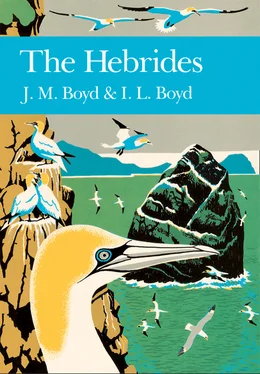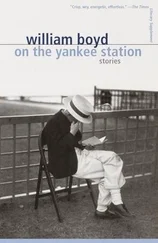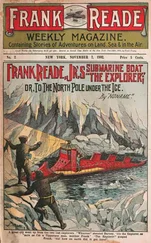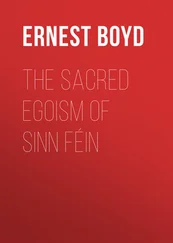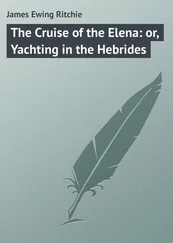The writer of a natural history of such a diverse environment as the Hebrides is faced with a vast span in geological age, an enormous number of distinct forms of life, all of which are specially adapted to their living quarters, a wide range of temperate maritime habitats, and a group of human influences and impacts on the environment, rooted in Celtic and Norse cultures, strikingly different from those in mainland Britain. This great assembly is positively dynamic. It is not sufficient, therefore, to provide a ‘snapshot’ of nature today, but also to apply the dimension of history and unrelenting change. To encompass the work in a single volume was firstly a matter of eclecticism and presentation of part of the available knowledge; secondly, of consultation with experts over each chapter; and thirdly, the incorporation of these experts’ comments.
The objective is a wholesome natural history. The chapters do not stand on their own, but are interdependent. They are not specialist essays written without regard to the total ecological purpose of the book or the readership to which it is directed. I am deeply aware that its shape and content are a matter of my personal choice—I found it difficult to decide what should be excluded, and there are many studies which deserve mention and which, in the hands of another compiler, would find a place. The fact that some works are restricted to a mention in the Bibliography does not necessarily reflect their importance in natural history.
I required a co-author to assist me in the review of the literature, primary drafting and editing of my text, the incorporation of expert comment, and the application to the work of the judgment and taste of a younger scientist. I did not require to look further than my second son, Ian Lamont Boyd. He made his first visit to the Hebrides in infancy, and came face to face with his study animal, the grey seal, for the first time on Gunna at the age of 19 months. Throughout his boyhood he was continuously on foot with me in the islands and later, like myself, had the benefit of a broadly-based degree in natural science from a Scottish university. He was awarded First Class Honours in zoology at Aberdeen, followed by a Doctorate at Cambridge with a thesis on the reproductive biology of the grey seal. Ian is now in charge of seal research in the British Antarctic Survey.
Stark rocks stand in the sea:
Curved islands against the sunset.
Oh Hebrides! What are you telling me?
I know wherein thy strength is set.
In thy beauty which I oft-times see
In ancient sea-girt, pillared rock beset,
By thrift and auk and cuckoo-bee.
J. Morton Boyd
Balephuil
Isle of Tiree
When I was a little boy the Garden of Hesperides, Hy Brasil and the Hebrides were in a curious way one in my mind. Two of these places are mythical; the Hebrides are real, but they reach into a legendary past and the limbo of my own mind and so, the Hebrides, however romantic they may have been in their beginnings in me, became a country which had to be trodden.
F. Fraser Darling
It is the purpose of this book to describe that reality of the Hebrides of which Fraser Darling was so conscious, and which has been experienced by many who have trodden the islands over the last few centuries. They were men and women of different philosophies and sciences, whose love of the islands and curiosity has taken them, with great energy and enthusiasm, into the remotest places. Many have left faithful accounts of their observations and experiences, though the literature can only be a minor part of the story. The remainder is held in notebooks, and in the memory of a community possessing a strong oral tradition. Every pair of eyes that has observed and every mind that has interpreted the passing scene, has been different. Naturalists have worked, alone and in groups, to produce a vast number of separate vignettes in a great natural history. Certainly, the Hebrides have been trodden!

The Soay Sound, St Kilda, looking from Hirta to Soay with Stac Biorach (73m) in the chasm (Photo J. M. Boyd)
Islands in Natural History
Islands cast a romantic spell upon people. They possess a mystique from which the pragmatist cannot escape, nor for which the scientist can find ready explanation. Nevertheless, this spell is real in island life, and engenders deep intellectual and physical responses in human beings. In the Hebrides themselves, it is an experience which many share, but which is deeply personal, and indicative of a singular, inner passion for the ultima thule. Charles Darwin knew it. According to Frank Sulloway (1984), Darwin raised the level of mystique of the Galapagos to that of ‘enchanted islands’ (which is the literal translation of galapagos from Spanish), in such unromantic works as biology textbooks and histories of science—so much so, that these islands have become ‘the highly acclaimed symbol of one of the greatest revolutions in Western intellectual thought’. Twenty-four years were to elapse between Darwin’s visit to the Galapagos in 1835, and the Origin of Species (1859). It is clear therefore, that his ‘conversion’ to the evolution theory did not occur in the heroic setting portrayed in the popular history of science. The idea of natural selection did not occur to Darwin until 1837, almost two years after he visited the Galapagos. However, the legend of a supreme, ‘eureka-like’ discovery by the great naturalist coming face to face with evolution in the primeval islands lives on, and has fired the imagination of generations of on-coming biologists.
The Hebrides do not occupy a grand plinth in scientific history as do the Galapagos, but, like all other archipelagos, they have their own endowment of nature and well-kept secrets to be discovered and enjoyed. The Galapagos are celebrated for their biology, but their geology (Simkin, 1984) is far less illustrious than that of the Hebrides. In studies of evolution and biogeography, the oceanic islands are unmatched by islands, like the Hebrides, that are strung along the continental edges. However, in studies of geology, ecology and animal behaviour, the continental edge is of the greatest interest. For example, the natural environment of the British Isles can be described as ‘maritime’, when compared with continental Europe. In greater detail, the western seaboard, including the Hebrides, when compared with the bulk of mainland Britain, is termed ‘oceanic’, because the communities of plants and animals there thrive in moist, mild conditions, or are greatly affected by the sea. It is this contrast of living conditions and life forms which has broadly attracted biologists to the Hebrides, while the geologists have been attracted to the Pre-cambrian and Tertiary rocks which are poorly represented in Britain south of the Great Glen. There are ample opportunities to observe how the structure of habitats changes from south-east to north-west, and also how each island has acquired its own rock base and complement of living things. Indeed, each island has its own unique and rich potential for the study of natural processes.
Island Races
Every island has a ‘gene pool’ and, between the islands and the mainland ‘reservoir’, there is a constant but usually small ‘gene flow’. Each island is a unique assembly of species, which have been brought together by natural or man-assisted colonisation over long periods of time. Genetically, it is important to distinguish between ‘relict’ species which were present on the land before it became an island, and the colonisers which arrived after the land became an island. Small founder groups of either category possess fewer alleles of each gene than the large mainland populations from which they derive. When the founder group has grown and becomes established, the island species can have different frequencies of the different morphs than in the parent population. This is the theory anyway—in reality the situation is much more complex.
Читать дальше
